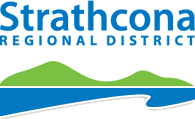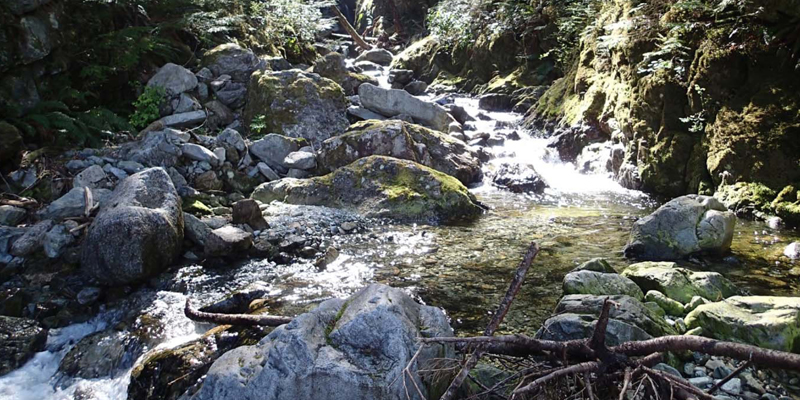Overview – Ecosystems of the Discovery Islands
The Discovery Islands are a forested archipelago nestled between Vancouver Island and the rugged mountains of BC’s mainland coast.  The islands are uniquely situated at the confluence of mountains and ocean, at the junction of tidal flows, between distinctly different ecoregions, and at the edge of BC’s coastal wilderness. Colliding influences create rich diversity of habitats in a dynamic mosaic of ecosystems that includes shorelines, estuaries, creeks, wetlands, ponds and lakes, meadows, woodlands, forests, and cliffs. Some of these ecosystems are rare and fragile and some provide niche habitats for species at-risk. These are sensitive ecosystems and they have special ecological significance. The area’s natural wealth also inspires resource extraction and other land use impacts that threaten sensitive ecosystems.
The islands are uniquely situated at the confluence of mountains and ocean, at the junction of tidal flows, between distinctly different ecoregions, and at the edge of BC’s coastal wilderness. Colliding influences create rich diversity of habitats in a dynamic mosaic of ecosystems that includes shorelines, estuaries, creeks, wetlands, ponds and lakes, meadows, woodlands, forests, and cliffs. Some of these ecosystems are rare and fragile and some provide niche habitats for species at-risk. These are sensitive ecosystems and they have special ecological significance. The area’s natural wealth also inspires resource extraction and other land use impacts that threaten sensitive ecosystems.
Find more information about BC’s Sensitive Ecosystems Inventory and the DIEM mapping HERE: DIEM Report 8MB
Marine Interface Ecosystems
The intertidal and estuarine are marine interface ecosystems at the island-ocean edge. These marine interface ecosystems are influenced by the ocean’s temperature, winds, waves and nutrient exchange; they experience repeated tidal exposure and drying, and their salinity and temperature fluctuate with freshwater inputs and exposure to the sun. They provide unique habitats for diverse marine life as well as many terrestrial species.
Intertidal and estuarine ecosystems are valued by humans for food and recreation, and they are favoured as sites for development and transportation. Human activities and upland settlement impact and frequently damage the marine interface ecosystems.
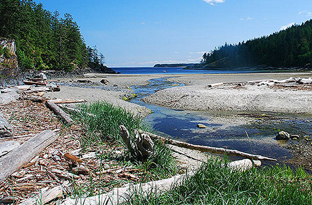
Intertidal Ecosystems
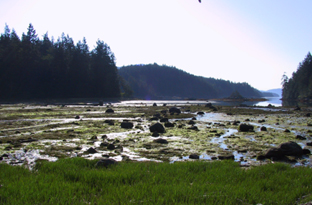
Estuarine Ecosystems
Exposed Terrestrial Ecosystems
Sparsely Vegetated and Herbaceous ecosystems are found along the coast and inland where tree growth is limited. These exposed terrestrial ecosystems include cliffs, rocky outcrops, and small natural meadows that are rare in coastal BC’s mostly forested terrain. Sparsely Vegetated and Herbaceous ecosystems are fragile and challenging environments where plants are slow to establish and easily disturbed. They often have specialized micro-habitats with breath-taking displays of uniquely adapted wildflowers, lichens, birds and butterflies that contribute to the spectacular beauty of the region.
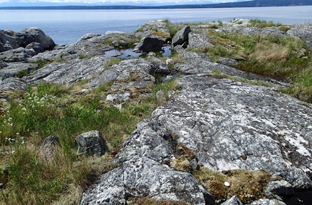
Sparsely Vegetated Ecosystems
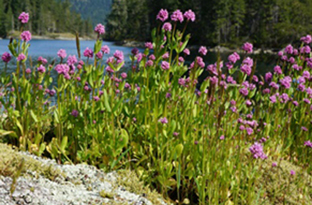
Herbaceous Ecosystems
Freshwater Ecosystems
Freshwater ecosystems are a vital part of the water cycle that nourishes all life on earth. They are all fed by precipitation that drains from surrounding lands, and the water within an ecosystem can be still as in a pond, or running as in a creek. The Discovery Islands’ freshwater ecosystems include Creeks, Wetlands, Ponds and Lakes – and the linear ecosystem commonly called the Riparian. Riparian ecosystems are the corridors that provide transition between every freshwater and terrestrial ecosystem. The organisms found in creeks, ponds, and wetlands vary according to which habitat conditions best support them. Most Creeks are relatively oxygen-rich. Species adapted to them are rare or absent in the still waters of lakes and ponds. Wetlands are often a mosaic of several wetland types, including bogs, fens, marshes, swamps and shallow-waters; Wetlands frequently interconnect with adjacent freshwater and forested ecosystems. Wetland and Riparian ecosystems provide filtration that removes sediment and pollutants to keep creeks clean. They also help moderate water levels and prevent flooding. Ponds and Lakes provide a rich source of nutrients for aquatic and terrestrial inhabitants, as well as breeding habitat for amphibians, fish, insects and other invertebrates. Many other species rely on the water, food, and shelter provided by the Freshwater Ecosystems and the valuable edge-habitats between aquatic and other ecosystems.

Riparian & Creek Ecosystems

Wetland Ecosystems

Freshwater Lake & Pond Ecosystems
Forest Ecosystems
Woodland and forests are treed ecosystems that provide a wealth of ecosystem services. They are dynamic places subject to many kinds of change, including natural disturbances and human impacts. Left alone, forests display incredible resiliency over time and they are always growing in complexity. Old forests contain huge amounts of biomass and provide habitats for a tremendous diversity of plants and animals. Forests protect the region’s watersheds and air quality, and store carbon that helps to mitigate climate change. Forested ecosystems in the Discovery Islands range from dry open woodlands to giant veteran trees and patches of intact old forest. Woodland, Old Forest and Karst are classified as Sensitive Ecosystems.

Old Forest Ecosystems
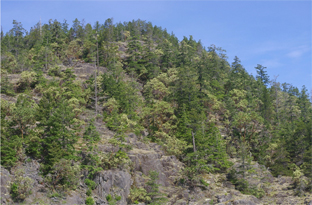
Woodlands Ecosystems
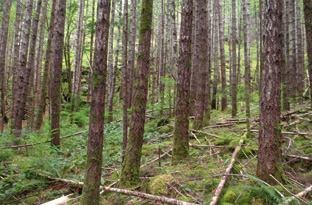
Young and Mature Forest Ecosystems
Young Forest and Mature Forest are classified as Other Important Ecosystems
Other Important Ecosystems
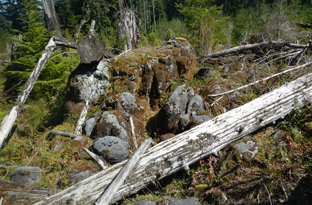
Karst
Ecosystems
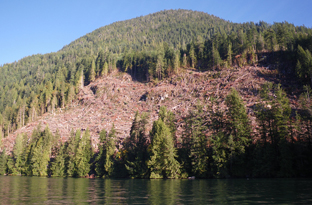
Disturbed Ecosystems

